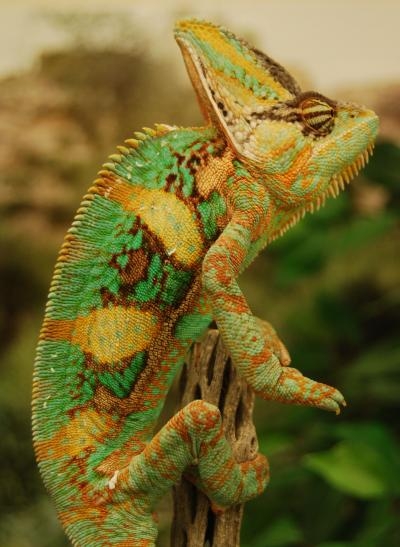So far, it was believed that the chameleons change color to match to their background, which’ll make them safer as then it’ll be difficult to locate them. However, as per a new research done on veiled chameleons (Chameleon calyptratus), changing color is meant to communicate other information as well than just to camouflage. Male chameleons have been seen using the change in colors as a signal to ward off its enemy.
Researchers from Arizona State University, observed the bright color stripes on the side and top of the male chameleons, when fighting for the territory or to win a female. It was also seen that the chances for winning was more for the chameleons with faster and more conspicuous colors than the one with the lighter shades. Thus implying that change in colors convey certain messages though it is still under study as to what extend these changes matter in competitions.
For the study, Dr Russell Ligon an ASU doctoral student on the research team and his colleagues observed one on one clashes a-midst ten veiled chameleons. The chameleons were paired in 45 different combinations and each paired was kept separated for 30 minutes each. For the observation, a digital camera took the photo of each isolated pair at every 4 seconds. The researchers with the photo found 28 different patches on each chameleon.
They found that the chameleons with brighter color stripes dominated the one with the duller stripes. And at times the duller color chameleons chooses to back off instead of giving a fight to its enemy with brighter stripes. In case of competition chameleons that changes the color faster and had brighter colors on the top the head, were likely to win the fight. The researcher thus believed that the bright colors are the indication of good health and physical strength. Nevertheless, it is still unclear how the individual chameleons understand these ranking.
As Ligon said :
It’s possible that there is some overall template that the chameleons can recognize and place other individuals on that scale, possibly for them to get a sense for how worthwhile it might be to continue to pursue an interaction or call it off,
Another researcher Devi Meian Stuart-Fox from University of Melbourne studying chameleons in Australia said:
It shows for the first time that the speed of color change can affect contest dynamics — a discovery only possible because of the sophisticated way they quantified color change.
Stuart further said that the study was conducted on one species of chameleons but she believes the same rule applies to other color changing lizards as well. And such studies will help the scientist to understand the diversity of signals existing in the animal world.
The team now aims to extend the study to other species of color changing lizards to understand how the color change varies in different species. They are also planning to conduct experiments by manipulating the colors of the chameleons to reproduce the results of the research done so far.
Source: Nature World News





[…] are often fascinated by the bright colors of the animals. In nature, these bright colors of the animals are not just to impress females or a fashion […]